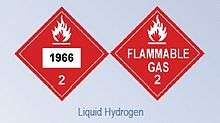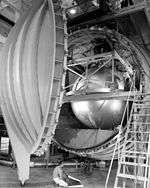Liquid hydrogen
| |||
| Names | |||
|---|---|---|---|
| IUPAC name
Liquid hydrogen | |||
| Other names
Hydrogen (cryogenic liquid); hydrogen, refrigerated liquid; LH2, para-hydrogen | |||
| Identifiers | |||
| 1333-74-0 | |||
| 3D model (Jmol) | Interactive image | ||
| ChEBI | CHEBI:33251 | ||
| ChemSpider | 762 | ||
| KEGG | C00282 | ||
| PubChem | 783 | ||
| RTECS number | MW8900000 | ||
| UNII | 7YNJ3PO35Z | ||
| UN number | 1966 | ||
| |||
| |||
| Properties | |||
| H2 | |||
| Molar mass | 2.02 g·mol−1 | ||
| Appearance | Colorless liquid | ||
| Density | 70.85 g/L (4.423 lb/cu ft)[1] | ||
| Melting point | −259.14 °C (14.01 K; −434.45 °F)[2] | ||
| Boiling point | −252.87 °C (20.28 K; −423.17 °F)[2] | ||
| Hazards | |||
| EU classification (DSD) |
| ||
| NFPA 704 | |||
| 571 °C (1,060 °F; 844 K)[2] | |||
| Explosive limits | LEL 4.0 %; UEL 74.2 % (in air)[2] | ||
| Except where otherwise noted, data are given for materials in their standard state (at 25 °C [77 °F], 100 kPa). | |||
| | |||
| Infobox references | |||
Liquid hydrogen (LH2 or LH2) is the liquid state of the element hydrogen. Hydrogen is found naturally in the molecular H2 form.
To exist as a liquid, H2 must be cooled below hydrogen's critical point of 33 K. However, for hydrogen to be in a fully liquid state without boiling at atmospheric pressure, it needs to be cooled to 20.28 K[3] (−423.17 °F/−252.87 °C).[4][5] One common method of obtaining liquid hydrogen involves a compressor resembling a jet engine in both appearance and principle. Liquid hydrogen is typically used as a concentrated form of hydrogen storage. As in any gas, storing it as liquid takes less space than storing it as a gas at normal temperature and pressure. However, the liquid density is very low compared to other common fuels. Once liquefied, it can be maintained as a liquid in pressurized and thermally insulated containers.
Liquid hydrogen consists of 99.79% parahydrogen, 0.21% orthohydrogen.[6]
History
In 1885 Zygmunt Florenty Wróblewski published hydrogen's critical temperature as 33 K; critical pressure, 13.3 atmospheres; and boiling point, 23 K.
Hydrogen was liquefied by James Dewar in 1898 by using regenerative cooling and his invention, the vacuum flask. The first synthesis of the stable isomer form of liquid hydrogen, parahydrogen, was achieved by Paul Harteck and Karl Friedrich Bonhoeffer in 1929.
Spin isomers of hydrogen
Room–temperature hydrogen consists mostly of the orthohydrogen form. After production, liquid hydrogen is in a metastable state and must be converted into the parahydrogen isomer form to avoid the exothermic reaction that occurs when it changes at low temperatures; this is usually performed using a catalyst like iron(III) oxide, activated carbon, platinized asbestos, rare earth metals, uranium compounds, chromium(III) oxide, or some nickel compounds.[7]
Uses
It is a common liquid rocket fuel for rocket applications. In most rocket engines fueled by liquid hydrogen, it first cools the nozzle and other parts before being mixed with the oxidizer (usually liquid oxygen (LOX)) and burned to produce water with traces of ozone and hydrogen peroxide. Practical H2–O2 rocket engines run fuel-rich so that the exhaust contains some unburned hydrogen. This reduces combustion chamber and nozzle erosion. It also reduces the molecular weight of the exhaust which can actually increase specific impulse despite the incomplete combustion.
 | |
| RTECS | MW8900000 |
|---|---|
| PEL-OSHA | Simple asphyxiant |
| ACGIH TLV-TWA | Simple asphyxiant |
Liquid hydrogen can be used as the fuel for an internal combustion engine or fuel cell. Various submarines (Type 212 submarine, Type 214 submarine) and concept hydrogen vehicles have been built using this form of hydrogen (see DeepC, BMW H2R). Due to its similarity, builders can sometimes modify and share equipment with systems designed for LNG. However, because of the lower volumetric energy, the hydrogen volumes needed for combustion are large. Unless LH2 is injected instead of gas, hydrogen-fueled piston engines usually require larger fuel systems. Unless direct injection is used, a severe gas-displacement effect also hampers maximum breathing and increases pumping losses.
Liquid hydrogen is also used to cool neutrons to be used in neutron scattering. Since neutrons and hydrogen nuclei have similar masses, kinetic energy exchange per interaction is maximum (elastic collision). Finally, superheated liquid hydrogen was used in many bubble chamber experiments.
Properties

The product of its combustion with oxygen alone is water vapor (although if its combustion is with oxygen and nitrogen it can form toxic chemicals), which can be cooled with some of the liquid hydrogen. Since water is harmless to the environment, an engine burning it can be considered "zero emissions." Liquid hydrogen also has a much higher specific energy than gasoline, natural gas, or diesel.[8]
The density of liquid hydrogen is only 70.99 g/L (at 20 K), a relative density of just 0.07. Although the specific energy is around twice that of other fuels, this gives it a remarkably low volumetric energy density, many fold lower.
Liquid hydrogen requires cryogenic storage technology such as special thermally insulated containers and requires special handling common to all cryogenic fuels. This is similar to, but more severe than liquid oxygen. Even with thermally insulated containers it is difficult to keep such a low temperature, and the hydrogen will gradually leak away (typically at a rate of 1% per day[8]). It also shares many of the same safety issues as other forms of hydrogen, as well as being cold enough to liquefy (and possibly solidify) atmospheric oxygen which can be an explosion hazard.
The triple point of hydrogen is at 13.81 K[3] 7.042 kPa.[9]
See also
- Industrial gas
- Liquefaction of gases
- Hydrogen safety
- Compressed hydrogen
- Cryo-adsorption
- Expansion ratio
- Gasoline gallon equivalent
- Slush hydrogen
- Solid hydrogen
- Metallic hydrogen
- Hydrogen infrastructure
- Hydrogen-powered aircraft
- Liquid hydrogen tank car
- Liquid hydrogen tanktainer
- Liquid hydrogen tank truck
References
- ↑ Thermophysical Properties of Hydrogen , nist.gov, accessed 2012-09-14
- 1 2 3 4 Information specific to liquid hydrogen, harvard.edu, accessed 2009-06-12
- 1 2 IPTS-1968, iupac.org, accessed 2009-06-12
- ↑ Chemical elements data references
- ↑ Properties Of Gases. Roymech.co.uk. Retrieved on 2011-08-28.
- ↑ Liquid Air/LH2. Astronautix.com. Retrieved on 2011-08-28.
- ↑ Ortho-Para conversion. Page 13. (PDF) . Retrieved on 2011-08-28.
- 1 2 Hydrogen As an Alternative Fuel. Almc.army.mil. Retrieved on 2011-08-28.
- ↑ Yunus A. Cengel, Robert H. Turner. Fundamentals of thermal-fluid sciences, McGraw-Hill, 2004, p. 78, ISBN 0-07-297675-6


